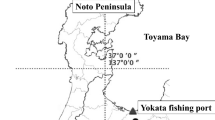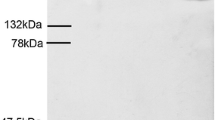Abstract
In the chain of study to further elucidate the role of retinoid X receptor (RXR) in the development of imposex caused by organotin compounds in gastropod mollusks, we established a polyclonal antibody against RXR of the rock shell Thais clavigera. Immunoblotting demonstrated that this antibody could recognize T. clavigera RXR. In males and imposex-exhibiting females, immunohistochemical staining with the antibody revealed nuclear localization of RXR protein in the epithelial and smooth muscle cells of the vas deferens and in the interstitial and epidermal cells of the penis. These results suggest that the polyclonal antibody against T. clavigera RXR can specifically recognize RXR protein in tissues of T. clavigera and therefore is useful for evaluating RXR protein localization. Furthermore, RXR may be involved in the induction of male-type genitalia (penis and vas deferens) in normal male and organotin-exposed female rock shells.



Similar content being viewed by others
Explore related subjects
Discover the latest articles, news and stories from top researchers in related subjects.References
Bettin C, Oehlmann J, Stroben E (1996) TBT-induced imposex in marine neogastropods is mediated by an increasing androgen level. Helgol Meeresunters 50:299–317
Bouton D, Escriva H, de Mendonca RL, Glineur C, Bertin B, Noël C, Robinson-Rechavi M, de Groot A, Cornette J, Laudet V, Pierce RJ (2005) A conserved retinoid X receptor (RXR) from the mollusk Biomphalaria glabrata transactivates transcription in the presence of retinoids. J Mol Endocrinol 34:567–582
Bryan GW, Gibbs PE, Hummerstone LG, Burt GR (1986) The decline of the gastropod Nucella lapillus around south-west England: evidence for the effect of tributyltin from antifouling paints. J Mar Biol Assoc UK 66:611–640
Bryan GW, Gibbs PE, Burt GR, Hummerstone LG (1987) The effects of tributyltin (TBT) accumulation on adult dog-whelk, Nucella lapillus: long-term field and laboratory experiments. J Mar Biol Assoc UK 67:525–544
Bryan GW, Gibbs PE, Burt GR (1988) A comparison of the effectiveness of tri-n-butyltin chloride and five other organotin compounds in promoting the development of imposex in the dog-whelk, Nucella lapillus. J Mar Biol Assoc UK 68:733–744
Devine C, Hinman VF, Degnan BM (2002) Evolution and developmental expression of nuclear receptor genes in the ascidian Herdmania. Int J Biol 46:687–692
Dmetrichuk JM, Carlone RL, Jones TRB, Vesprini ND, Spencer GE (2008) Detection of endogenous retinoids in the molluscan CNS and characterization of the trophic and tropic actions of 9-cis retinoic acid on isolated neurons. J Neurosci 28:13014–13024
Escriva H, Safi R, Hanni C, Langlois MC, Saumitou-Laprade P, Stehelin D, Capron A, Pierce R, Laudet V (1997) Ligand binding was acquired during evolution of nuclear receptors. Proc Natl Acad Sci USA 94:6803–6808
Féral C, Le Gall S (1983) The influence of a pollutant factor (TBT) on the neurosecretory mechanism responsible for the occurrence of a penis in the females of Ocenebra erinacea. In: Lever J, Boer HH (eds) Molluscan neuro-endocrinology. North-Holland Publishing, Amsterdam, pp 173–175
Fioroni P, Oehlmann J, Stroben E (1991) The pseudohermaphroditism of prosobranch: morphological aspects. Zool Anz 226:1–26
Freebern WJ, Osman A, Niles EG, Christen L, LoVerde PT (1999) Identification of a cDNA encoding a retinoid X receptor homologue from Schistosoma mansoni: evidence for a role in female-specific gene expression. J Biol Chem 247:4577–4585
Gibbs PE, Bryan GW (1986) Reproductive failure in populations of the dog-whelk, Nucella lapillus, caused by imposex induced by tributyltin from antifouling paints. J Mar Biol Assoc UK 66:767–777
Gibbs PE, Bryan GW, Pascoe PL, Burt GR (1987) The use of the dog-whelk, Nucella lapillus, as an indicator of tributyltin (TBT) contamination. J Mar Biol Assoc UK 67:507–523
Gibbs PE, Pascoe PL, Burt GR (1988) Sex change in the female dog-whelk, Nucella lapillus, induced by tributyltin from antifouling paints. J Mar Biol Assoc UK 68:715–731
Gibbs PE, Bryan GW, Pascoe PL, Burt GR (1990) Reproductive abnormalities in female Ocenebra erinacea (Gastropoda) resulting from tributyltin-induced imposex. J Mar Biol Assoc UK 70:639–656
Grün F, Blumberg B (2006) Environmental obesogens: organotins and endocrine disruption via nuclear receptor signaling. Endocrinology 147:S50–S55
Grün F, Watanabe H, Zamanian Z, Maeda L, Arima K, Cubacha R, Gardiner DM, Kanno J, Iguchi T, Blumberg B (2006) Endocrine-disrupting organotin compounds are potent inducers of adipogenesis in vertebrates. Mol Endocrinol 20:2141–2155
Heyman RA, Mangelsdorf DJ, Dyck JA, Stein RB, Eichele G, Evans RM, Thaller C (1992) 9-cis-retinoic acid is a high-affinity ligand for the retinoid X receptor. Cell 68:397–406
Horiguchi T (2004) Gastropods. In: Takeuchi I, Tanabe S, Hino A (eds) Biological monitoring for anthropogenic chemicals in low doses. Koseisha-Koseikaku, Tokyo, pp 37–67 (in Japanese)
Horiguchi T (2009) Mechanism of imposex induced by organotins in gastropods. In: Arai T, Harino H, Ohji M, Langston WJ (eds) Ecotoxicology of antifouling biocides. Springer, Tokyo, pp 111–124
Horiguchi T, Shiraishi H, Shimizu M, Morita M (1994) Imposex and organotin compounds in Thais clavigera and T. bronni in Japan. J Mar Biol Assoc UK 74:651–669
Horiguchi T, Shiraishi H, Shimizu M, Morita M (1997a) Effects of triphenyltin chloride and five other organotin compounds on the development of imposex in the rock shell, Thais clavigera. Environ Pollut 95:85–91
Horiguchi T, Shiraishi H, Shimizu M, Morita M (1997b) Imposex in sea snails, caused by organotin (tributyltin and triphenyltin) pollution in Japan: a survey. Appl Organomet Chem 11:451–455
Horiguchi T, Kojima M, Hamada F, Kajikawa A, Shiraishi H, Morita M, Shimizu M (2006) Impact of tributyltin and triphenyltin on ivory shell (Babylonia japonica) populations. Environ Health Perspect 114(Suppl. 1):13–19
Horiguchi T, Nishikawa T, Ohta Y, Shiraishi H, Morita M (2007) Retinoid X receptor gene expression and protein content in tissues of the rock shell Thais clavigera. Aquat Toxicol 84:379–388
Horiguchi T, Ohta Y, Nishikawa T, Shiraishi F, Shiraishi H, Morita M (2008) Exposure to 9-cis retinoic acid induces penis and vas deferens development in the female rock shell, Thais clavigera. Cell Biol Toxicol 24:553–562
Kamimura M, Fujiwara S, Kawamura K, Yubisui T (2000) Functional retinoid receptors in budding ascidians. Dev Growth Differ 42:1–8
Kanayama T, Kobayashi N, Mamiya S, Nakanishi T, Nishikawa J (2005) Organotin compounds promote adipocyte differentiation as agonist of the peroxisome proliferators-activated receptor γ/retinoid X receptor pathway. Mol Pharmacol 67:766–774
Kostrouch Z, Kostrouchova M, Love W, Jannini E, Piatigorsky J, Rall JE (1998) Retinoic acid X receptor in the diploblast, Tripedalia cystophora. Proc Natl Acad Sci USA 95:13442–13447
Laemmli UK (1970) Cleavage of structural proteins during the assembly of the head of bacteriophage T4. Nature 227:680–685
le Maire A, Grimaldi M, Roecklin D, Dagnino S, Vivat-Hannah V, Balaguer P, Bourguet W (2009) Activation of RXR-PPAR heterodimers by organotin environmental endocrine disruptors. EMBO Rep 10:367–373
Mangelsdorf DJ, Evans RM (1995) The RXR heterodimers and orphan receptors. Cell 83:841–850
Mangelsdorf DJ, Borgmeyer U, Heyman RA, Zhou JY, Ong ES, Oro AE, Kakizuka A, Evans RM (1992) Characterization of three RXR genes that mediate the action of 9-cis-retinoic acid. Genes Dev 6:329–344
Matthiessen P, Gibbs PE (1998) Critical appraisal of the evidence for tributyltin-mediated endocrine disruption in mollusks. Environ Toxicol Chem 17:37–43
Matthiessen P, Reynoldson T, Billinghurst Z, Brassard DW, Cameron P, Chandler GT, Davies IM, Horiguchi T, Mount DR, Oehlmann J, Pottinger TG, Sibley PK, Thompson A, Vethaak AD (1999) Field assessment for endocrine disruption in invertebrates. In: de Fur PL, Ingersoll C, Tattersfield L (eds) Endocrine disruption in invertebrates: endocrinology, testing, and assessment. SETAC Press, Pensacola, Florida, pp 199–270
Morris-Kay GM (1997) Retinoids in mammalian embryonic development. In: Sherbet GV (ed) Retinoids: their physiological function and therapeutic potential. JAI Press, Greenwich, pp 79–93
Nagatomo K, Fujiwara S (2003) Expression of Raldh2, Cyp26 and Hox-1 in normal and retinoic acid–treated Ciona intestinalis embryos. Gene Expr Patterns 3:273–277
Nagatomo K, Ishibashi T, Satou Y, Satoh N, Fujiwara S (2003) Retinoic acid affects gene expression and morphogenesis without upregulating the retinoic acid receptor in the ascidian Ciona intestinalis. Mech Dev 120:363–372
Nishikawa J, Mamiya S, Kanayama T, Nishikawa T, Shiraishi F, Horiguchi T (2004) Involvement of the retinoid X receptor in the development of imposex caused by organotins in gastropods. Environ Sci Technol 38:6271–6276
Oberdörster E, McClellan-Green P (2000) The neuropeptide APGWamide induces imposex in the mud snail, Ilyanassa obsoleta. Peptides 21:1323–1330
Redfern CPF (1997) Molecular mechanisms of the retinoid function. In: Sherbet GV (ed) Retinoids: their physiological function and therapeutic potential. JAI Press, Greenwich, pp 35–77
Ronis MJJ, Mason AZ (1996) The metabolism of testosterone by the periwinkle (Littorina littorea) in vitro and in vivo: effects of tributyltin. Mar Environ Res 42:161–166
Smith BS (1971) Sexuality in the American mud snail, Nassarius obsoletus Say. Proc Malacol Soc Lond 39:377–378
Towbin H, Staehelin T, Gordon J (1979) Electrophoretic transfer of proteins from polyacrylamide gels to nitrocellulose sheets: Procedure and some applications. Proc Natl Acad Sci USA 76:4350–4354
Wiens M, Batel R, Korzhev M, Muller WE (2003) Retinoid X receptor and retinoic acid response in the marine sponge Suberites domuncula. J Exp Biol 206:3261–3271
Acknowledgments
This work was partly supported by grants from the Ministry of the Environment, Japan, and by Grants-in-Aid for Scientific Research from the Japan Society for the Promotion of Science (Scientific Research [B], no. 17380121).
Author information
Authors and Affiliations
Corresponding author
Rights and permissions
About this article
Cite this article
Horiguchi, T., Urushitani, H., Ohta, Y. et al. Establishment of a polyclonal antibody against the retinoid X receptor of the rock shell Thais clavigera and its application to rock shell tissues for imposex research. Ecotoxicology 19, 571–576 (2010). https://doi.org/10.1007/s10646-009-0447-6
Accepted:
Published:
Issue Date:
DOI: https://doi.org/10.1007/s10646-009-0447-6




